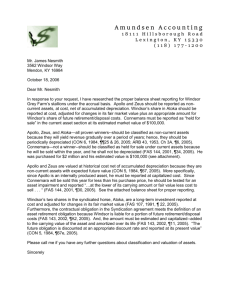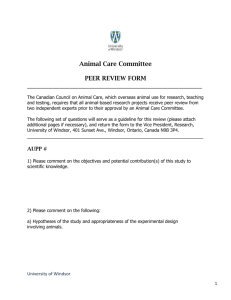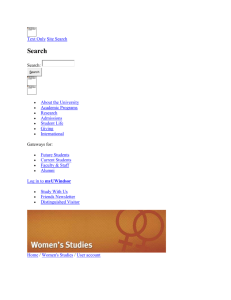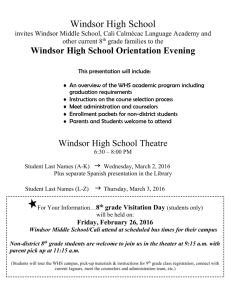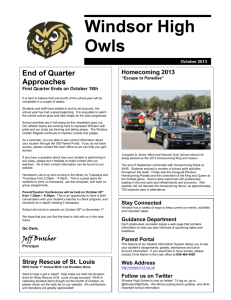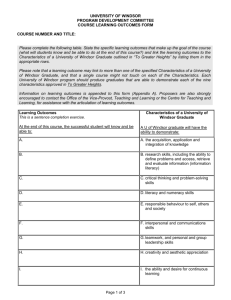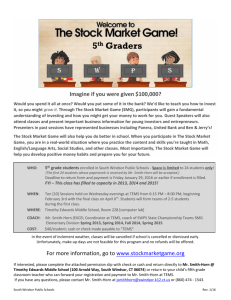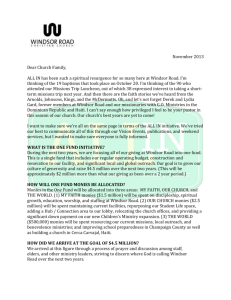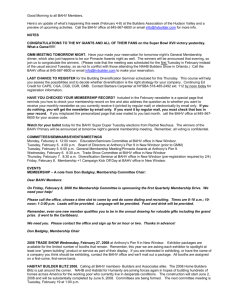MemoWindsor
advertisement
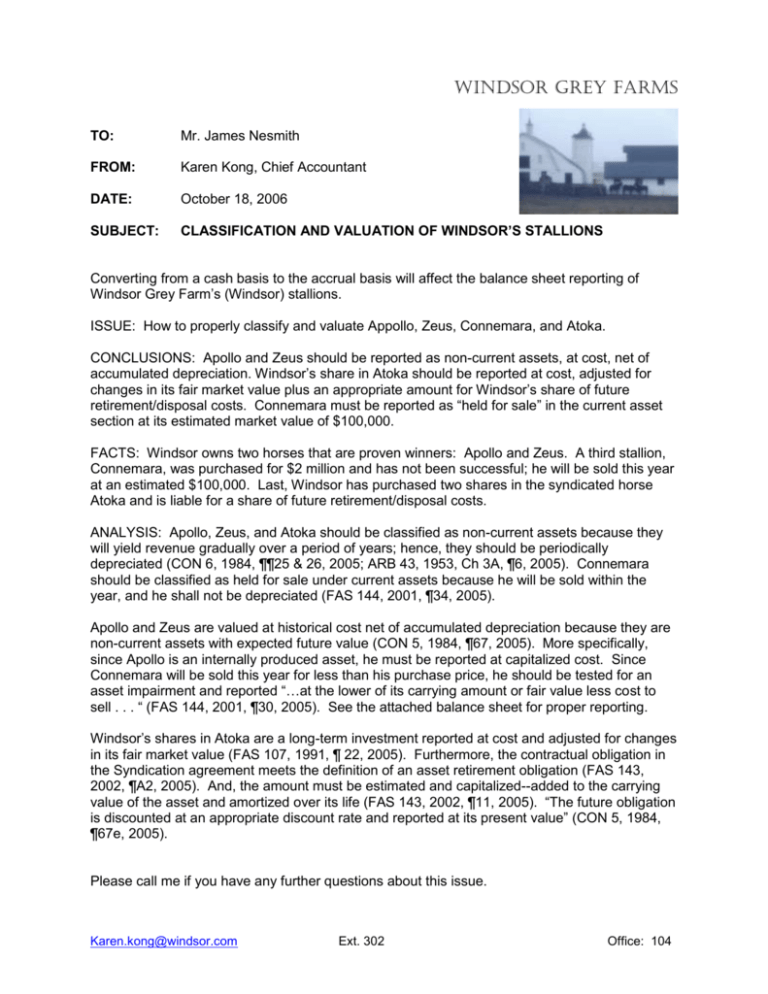
Windsor Grey Farms TO: Mr. James Nesmith FROM: Karen Kong, Chief Accountant DATE: October 18, 2006 SUBJECT: CLASSIFICATION AND VALUATION OF WINDSOR’S STALLIONS Converting from a cash basis to the accrual basis will affect the balance sheet reporting of Windsor Grey Farm’s (Windsor) stallions. ISSUE: How to properly classify and valuate Appollo, Zeus, Connemara, and Atoka. CONCLUSIONS: Apollo and Zeus should be reported as non-current assets, at cost, net of accumulated depreciation. Windsor’s share in Atoka should be reported at cost, adjusted for changes in its fair market value plus an appropriate amount for Windsor’s share of future retirement/disposal costs. Connemara must be reported as “held for sale” in the current asset section at its estimated market value of $100,000. FACTS: Windsor owns two horses that are proven winners: Apollo and Zeus. A third stallion, Connemara, was purchased for $2 million and has not been successful; he will be sold this year at an estimated $100,000. Last, Windsor has purchased two shares in the syndicated horse Atoka and is liable for a share of future retirement/disposal costs. ANALYSIS: Apollo, Zeus, and Atoka should be classified as non-current assets because they will yield revenue gradually over a period of years; hence, they should be periodically depreciated (CON 6, 1984, ¶¶25 & 26, 2005; ARB 43, 1953, Ch 3A, ¶6, 2005). Connemara should be classified as held for sale under current assets because he will be sold within the year, and he shall not be depreciated (FAS 144, 2001, ¶34, 2005). Apollo and Zeus are valued at historical cost net of accumulated depreciation because they are non-current assets with expected future value (CON 5, 1984, ¶67, 2005). More specifically, since Apollo is an internally produced asset, he must be reported at capitalized cost. Since Connemara will be sold this year for less than his purchase price, he should be tested for an asset impairment and reported “…at the lower of its carrying amount or fair value less cost to sell . . . “ (FAS 144, 2001, ¶30, 2005). See the attached balance sheet for proper reporting. Windsor’s shares in Atoka are a long-term investment reported at cost and adjusted for changes in its fair market value (FAS 107, 1991, ¶ 22, 2005). Furthermore, the contractual obligation in the Syndication agreement meets the definition of an asset retirement obligation (FAS 143, 2002, ¶A2, 2005). And, the amount must be estimated and capitalized--added to the carrying value of the asset and amortized over its life (FAS 143, 2002, ¶11, 2005). “The future obligation is discounted at an appropriate discount rate and reported at its present value” (CON 5, 1984, ¶67e, 2005). Please call me if you have any further questions about this issue. Karen.kong@windsor.com Ext. 302 Office: 104 Mr. James Nesmith October 18, 2006 Page 2 ATTACHMENT Windsor Grey Star Farm Balance Sheet As of 12/31/200x Assets Current Assets Horse held for sale $100,000 Non- current Assets Racing Stallions (net of accumulated depreciation) Long term investment $XXX,xxx $392,000 + PV of ARO REFERENCES Accounting Principles Board (APB). 1953. ARB 43—Restatement and revision of Accounting Research Bulletins. Ch 3A—Working capital. Section A, ¶6—Current assets and current liabilities. Accounting Research Bulletin. (2005). Financial Accounting Research System (FARS). Published by the Financial Accounting Standards Board. Financial Accounting Standards Board (FASB). 1984. CON 5—Recognition and measurement in financial statements of business enterprises. ¶67—Measurability. Fundamental Recognition Criteria. Statements of Financial Accounting Concepts. (2005). Financial Accounting Research System (FARS). Published by the Financial Accounting Standards Board. Financial Accounting Standards Board (FASB). 1984. CON 6—Elements of financial statements. ¶25—Assets. Statements of Financial Accounting Concepts. (2005). Financial Accounting Research System (FARS). Published by the Financial Accounting Standards Board. Financial Accounting Standards Board (FASB). 1984. CON 6—Elements of financial statements. ¶26—Characteristics of assets. Statements of Financial Accounting Concepts. (2005). Financial Accounting Research System (FARS). Published by the Financial Accounting Standards Board. Financial Accounting Standards Board (FASB). 1991. FAS 107—Disclosures about fair value of financial instruments. ¶22—Financial instruments with no quoted prices. Appendix A: Examples of Procedures for Estimating Fair Value. Financial Accounting Standard. (2005). Financial Accounting Research System (FARS). Published by the Financial Accounting Standards Board. Karen.kong@windsor.com Ext. 302 Office: 104 Mr. James Nesmith October 18, 2006 Page 3 Financial Accounting Standards Board. 2001. FAS 144—Accounting for the impairment or disposal of long-lived assets. ¶30—Long-lived assets to be disposed of by sale. Recognition. (2005). Financial Accounting Research System (FARS). Published by the Financial Accounting Standards Board. Financial Accounting Standards Board. 2001. FAS 144—Accounting for the impairment or disposal of long-lived assets. ¶34—Long-lived assets to be disposed of by sale. Measurement. (2005). Financial Accounting Research System (FARS). Published by the Financial Accounting Standards Board. Financial Accounting Standards Board. 2002. FAS 143—Accounting for asset retirement obligations. ¶A2—Appendix A: Implementation guidance, scope, legal obligation. FASB Statements. (2005). Financial Accounting Research System (FARS). Published by the Financial Accounting Standards Board. Financial Accounting Standards Board. 2002. FAS 143—Accounting for asset retirement obligations. ¶11—Disclosures about fair value of financial instruments. Standards of Financial Accounting and Reporting. (2005). Financial Accounting Research System (FARS). Published by the Financial Accounting Standards Board. Karen.kong@windsor.com Ext. 302 Office: 104
